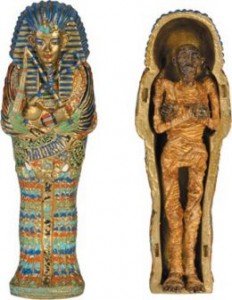The study of ancient Egypt is interesting as well as fascinating (Egypt Interesting Facts). Egypt was characterized by a uniqueness of its own. It ranges from Pepi II of Egypt who always kept several naked slaves nearby whose bodies were smeared with honey to get rid of flies to ‘Ramses the Great’ who had 8 official wives and nearly 100 concubines.
Following are Egypt Interesting Facts
But the most notable aspect of the great culture is constituted by the Pharaos, the rulers of the land, the Pyramids, a wonder of the world and last, but not the least, the Egyptian mummies.
Tutankhamun
Among the pharaos of those times, King Tutankhamun (1336-1327 BC) assumes a special place (Egypt Interesting Facts). He assumed throne when he was eight or nine years old. He was the 12th king of the 18th dynasty and ruled during the new kingdom. Not only his policies and reforms but also his tomb, mummy and cause of his death invite the attention of historians and the public as well. He ended the worship of god Aten, shifted the capital, erected monuments, built diplomatic relations and initiated battles.
The cause of the death of the king at the age of 25 remains a mystery. Tutankhamun was buried in a tomb that was small relative to his status. His death may have occurred unexpectedly, before the completion of a grander royal tomb, so that his mummy was buried in a tomb intended for someone else. His nearly intact tomb was discovered in 1922 by Howard Carter.
It sparked a renewed public interest in ancient Egypt, for which Tutankhamun’s burial mask remains the popular symbol. Exhibits of artefacts from his tomb have toured the world. Mask of Tutankhamun’s mummy is the popular icon for ancient Egypt at the Egyptian museum. Relics from Tutankhamun’s tomb are among the most travelled artefacts in the world. Tutankhamun was one of the few kings worshipped as a god and honoured with a cult-like following in his own lifetime.
The discovery of his tomb has helped the historians to learn comprehensively about Egyptian ways of life. Films are produced, Exhibitions are held and very many books are written based on his life and reign.
Pyramids
No other monument in the world is as famous or prominent as the Pyramids of Ancient Egypt. These icons, built mostly for the Pharaos remains a standing symbol of a community which existed somewhere in history.
It was only at the time of the Old Kingdom that the ancient Egyptians built pyramids. It is estimated that the pyramid contains approximately 2,300,000 blocks of stone. They were huge structures with storage rooms, courtyards, secret passageways, and all kinds of fancy traps designed to catch robbers who tried to break into the pyramid to rob it.
Pyramids had treasures, as the Egyptians believed in an afterlife. The cities which were developed around the pyramids were called pyramid cities. Mysteries of some well-known pyramids including the Great Pyramid of Khufu is yet to be unravelled. There are 138 pyramids discovered in Egypt as of 2008.
How the Egyptians managed the complex organisation of labour and the physical movement of large stone blocks is still a matter for debate. The earliest pyramid was the Step Pyramid of King Djoser of the Old Kingdom’s 3rd Dynasty over 4,600 years ago. The first true pyramid was the Red Pyramid developed for King Sneferu during the 4th Dynasty of the Old Kingdom. The largest pyramid ever built was the Great Pyramid at Giza southwest of modern Cairo which was built for King Khufu around 2550 BC. The last pyramid was built in Nubia in the 4th century AD.
Mummies

A mummy, in short, is the body of a person (or an animal) that has been preserved after death. Mummification is done to prevent the body from decaying. Mummies are made naturally or by embalming. The ancient Egyptians believed that mummifying a person’s body after death was essential to ensure a safe passage to the afterlife.
Mummification was a complex and expensive process, which depended on the financial status of the person being mummified. It took around 70 days to embalm a body. Pharaos had the most magnificent burials; Nobles and High-ranking officials had extensive burials as well.
The first step of mummification was washing the body and removing the deceased person’s internal organs; the intestines, the liver, the stomach and the lungs. The organs were embalmed using natron. Then the organs were individually wrapped using long strips of linen and placed in four canopic jars depicting the four sons of Horus; the Qebehsenuef, the Duamutef, the Hapy and the Imsety.
The heart was not removed as it was believed it was the soul. The brain was removed through the nose. The body was then placed on a slanted embalming table and completely covered with natron. This allowed fluids to drip away as the body slowly dried out. This took about forty days, after which the natron was removed, inside and out, to reveal a dried, shrunken body.
The head and body cavity were stuffed with packing. The mummy was then prepared for bandaging and made ready for burial. Once the mummy was finally prepared, it was time for the funeral. At the site of the tomb, religious ceremonies were held to prepare the dead for the afterlife. In particular, the Opening of the Mouth ceremony was believed to allow the mummy to see, hear, eat and drink in the spirit world.
Over time almost all Egyptians who could afford to become mummies when they died a total of about 70 million mummies in 3,000 years. By the 4th century AD, many Egyptians had become Christians and no longer believed that mummification was necessary for life after death. Eventually, the Egyptians gave up the art and science of making mummies (Egypt Interesting Facts). Though many mummies are robbed, attempts to preserve mummies have been successful to a certain extent.